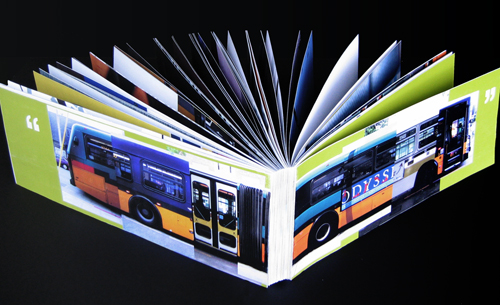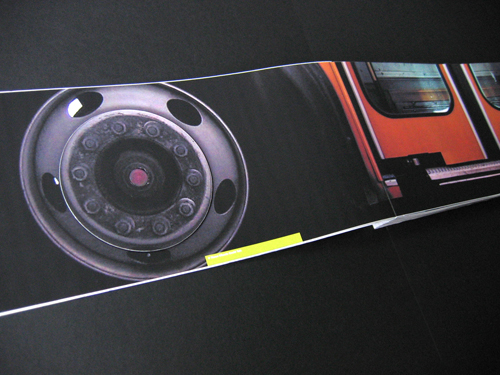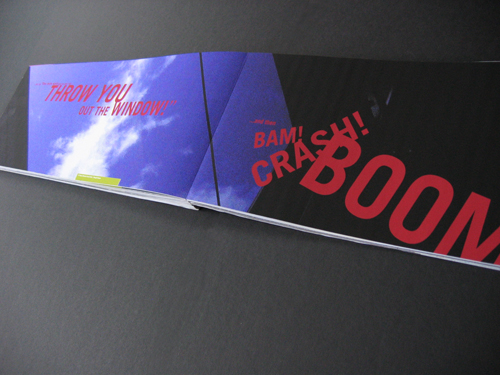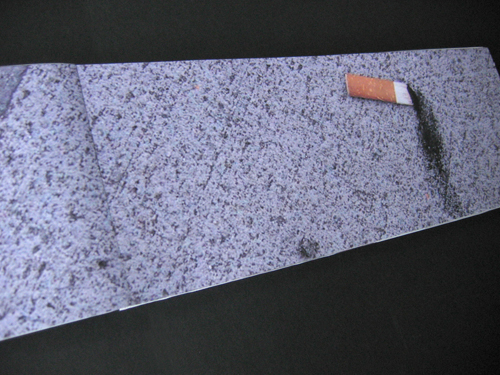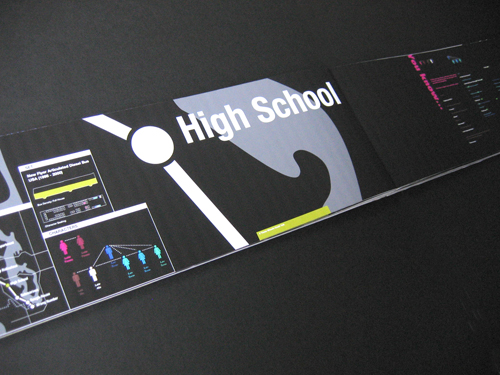If These Wheels Could Talk
December 23, 2011 at 3:24 pm · Filed under Content / Architecture, Copy / Writing, Information / Mapping, Naming / Words, Photography / Film, Print / Editorial
If These Wheels Could Talk book; 34 x 6.5in. (spread), 116ppg. / 2004
Soon after the dot-com and 9/11 crashes, my design job also crashed. I set about looking for another, through other firms, recruiters, friends, friends of friends, and so on. All unable to take on the frivolous weight of an underdeveloped type and image manipulator, I broadened my search criteria: assistant… receptionist… data enterer… Anything that would have me back in the office environs to which I had grown so entitled. But there was nothing to be had. Facing the loss of everything, the idealization of pre-crash innocence struck me. I printed out a few standard government forms, borrowed a friend’s car and found myself driving southward to the King County Metro headquarters. I was on my way to becoming a bus driver.
Public transportation is one of the great noble causes of our time, and the bus embodies the struggle most colossally: angling through bourgeois car traffic to transport the proletariat affordably to their destination. Having grown up without a car, I had developed a keen appreciation for the bus’s role, and, as the false hopes of cubicle walls crumbled, to give my hands to one of their great helms all of a sudden seemed right. But, for all my idealization, I also knew the motley reality of what goes on above the turning wheels: The bus riding masses are an odd bunch, particularly in a city where almost everyone who can drives a car instead…
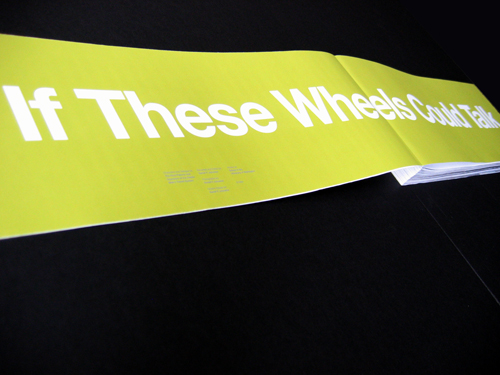
If These Wheels Could Talk title page; 34 x 6.5in. (spread), 116ppg. / 2004
Even before my career epiphany, the bus, and particularly those who rode it, had been so fascinating to me that I often ruminated that someone could (and should) write a book about it. Some years after my drive downtown, nearing the end of the Visual Communication Design (VCD) program at the University of Washington, I decided I would write that book. This was to be a documentary exploration into extra-ordinary human behavior, captured from a series of bus rides.
Of all the routes in Metro’s quiver, route 7 is one of the most eccentric, and, at the time of this project, I knew it quite well. It starts in the University District, with its preppy students and punkish homeless, then ambles up to Capitol Hill’s prideful exhibitionists and holy hipsters, turns around the plucky community college and then hurtles downtown, where business gets serious and youth goes to die. I lived in the middle and commuted to both ends. In homage to this moving cross-section, the book is composed as a series of seven rides.
Interaction with the book is meant to invoke the bus riding experience. The vehicle, itself, is large and unwieldy in every dimension. The book is 34″ across when straightened out, almost six inches thick, and quite heavy. The timetable of contents shows the journey you will take through the read, a legend of symbols (such as character descriptions and ambient noises like laughing or stop-bell ringing), and a timetable, so you know when your story is coming.
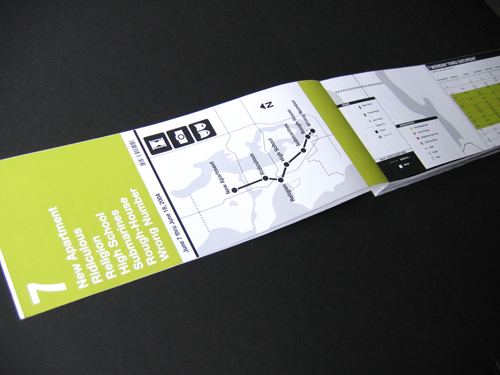
If These Wheels Could Talk table of contents; 34 x 6.5in. (spread), 116ppg. / 2004
Readers are invited into new stories by a new set of doors rolling up. For those who really want to immerse themselves in the bus ride experience while careening through the book, a CD of ambient bus noise sits on the hub of the first wheel.
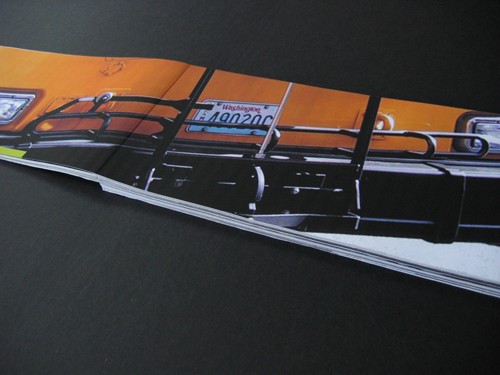
If These Wheels Could Talk spread (story coming); 34 x 6.5in., 116ppg. / 2004
If These Wheels Could Talk spread (story arrival); 34 x 6.5in., 116ppg. / 2004
A true connoisseur of the bus understands the implications of everything from the machine to the madness within. Express routes traversing the city and then ending in the bus tunnel downtown had been taken in beautiful Italian Bredas that would convert from diesel to electric “trolley” mode via long, raisable contact rods that would slide power from a dense network of live overhead wires. Sadly, these were being overtaken by the criminally ugly, though presumably more practical Canadian New Flyers, which were truer hybrids in that they no longer needed the trolley wires to sustain electric power. Before even the Bredas were the German M.A.N. machines of equivalent industrial elegance but, by this point had only kept presence with aging, 100% electric trolleys on local urban routes; their sophisticated gestalt belied an obstreperous tendency to toss their electric contact rods (and thus, all power) if corners weren’t taken with surgical accuracy. Filling in the gaps were useful, if unremarkable, American Gillig Diesels. Depending on the day and time, the number 7 may have employed any of these buses.
Once inside one of the great battlewagons, the real psychological war begins. Within each bus is a series of micro neighborhoods: Elderly, lonely and confused up front, huddled masses in the low front-facing rows, superior types high over the wheel wells, focused readers and motion-starved toddlers in the windowless, articulating mid-section and conniving youth slammed as rearward as possible. To mismatch your persona with the expectations of the community could be uncomfortable at best. However, increased rider density of any given route will dissipate these presumptions.
As you enter a story, a page lets you know where you are in the route, what kind of bus is taking you, how full it was, who the primary characters were and where they sat.
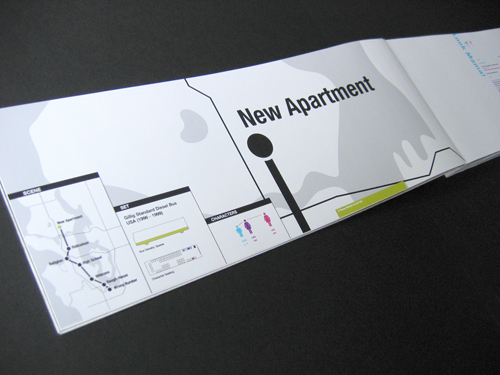
If These Wheels Could Talk spread (chapter head); 34 x 6.5in., 116ppg. / 2004
Technically, of course, I didn’t write this book. I could have, I suppose, but I thought it would be a hell of a lot more interesting if the people on the bus wrote it, themselves. In order to make this happen, I recorded conversations going on around me on my everyday commutes, then merely transcribed them upon returning home every night. The final seven stories were culled from about 25 ride recordings.
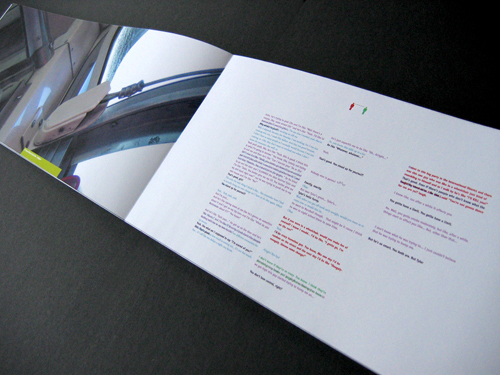
If These Wheels Could Talk spread (story text); 34 x 6.5in., 116ppg. / 2004
The text of the conversation is set temporally. Gaps in conversation correspond to gaps in typography. Similarly, when more than one person speaks at a time, type overlaps. Though the book is over 100 pages, there are no page numbers. Rather, a small clock ticks by at the right side of each spread. Each character is given a color, icon and a typeface that correspond to their gender, age, and personality as I could glean them from my brief overhearings. New entrants to the story are cued with their icons as they become audible, as they so often do.
Concurrently with, and helping to deflect from, my overhearing, I shot photography of the great machines and their surroundings for abstract visual context. Marbled rubber flooring, cracked vinyl seats and polished steel railings met with glimpses of light and corners as I rolled through the streets.
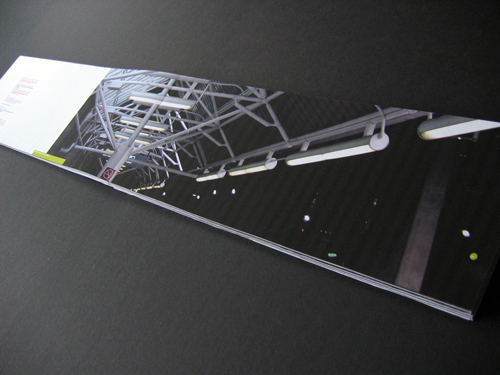
If These Wheels Could Talk spread (story / imagery); 34 x 6.5in., 116ppg. / 2004
Most of the text is actually quite small. It is the equivalent of the din of public chatter. It’s temporal setting and iconic cues offer a sense of volume and pace. But you don’t have to overhear very hard before someone says something that jumps clearly above white noise. Such gems were treated as pull quotes, set emotively within the photographic glimpses.
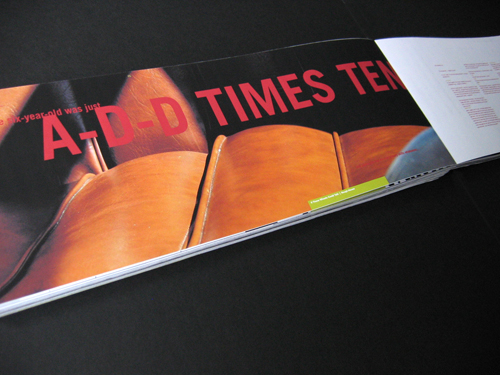
If These Wheels Could Talk spread (story / imagery / pull quote); 34 x 6.5in., 116ppg. / 2004
If These Wheels Could Talk spread (story / imagery / pull quote); 34 x 6.5in., 116ppg. / 2004
If you’re lucky, your point A and point B are driven between, directly, by one Metro bus. However, this is by no means guaranteed, particularly if those points are separated by some distance and/or are not represented as a stop within the downtown bus tunnel. For all other trips, you must transfer. As with most tax-starved public programs, I had learned early in my life to temper expectations of service, but the bus would almost always find a way to let me down, and never so low as when I was forced to wait to transfer to another bus. In order to bring this element into the frame, the book is not set up as a continuous ride with seven stops but, rather, seven consecutive rides with six transfers in-between, forcing you to wait between stories. Often for much longer than seems necessary.
It can take forever.
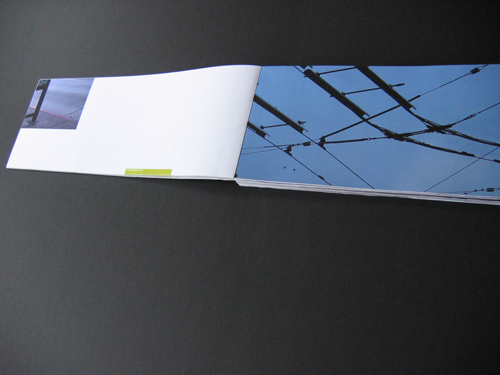
If These Wheels Could Talk spread (waiting); 34 x 6.5in., 116ppg. / 2004
Sometimes, just looking around can be interesting, though.
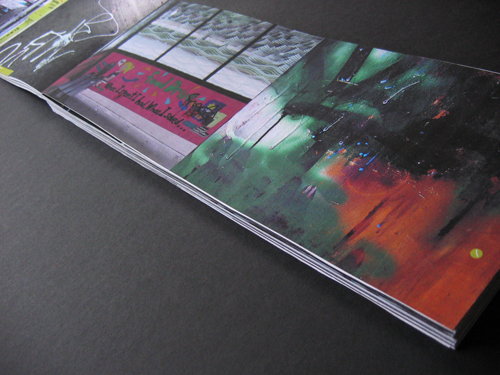
If These Wheels Could Talk spread (waiting); 34 x 6.5in., 116ppg. / 2004
If These Wheels Could Talk spread (waiting); 34 x 6.5in., 116ppg. / 2004
…and waiting.
Printed Metro schedules were useless because buses could never, ever stick to them. I always thought that buses should have tracking devices that would show, on a route map at every stop, where it actually was (a simple LED on the line would suffice). That way, you could make an informed decision about whether to wait, walk, cry, or go back home. But they still print schedules, anyway.
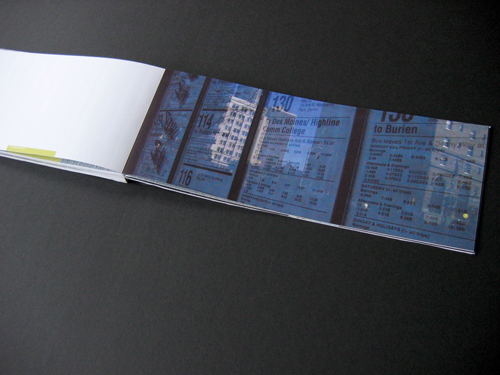
If These Wheels Could Talk spread (waiting); 34 x 6.5in., 116ppg. / 2004
If daytime ridership seems odd, then take a trip at night and prepare to redefine normal. Take away the people on their way to something productive and you’re left with a rare breed of incoherent vagabonds, charged up ramblers and the completely deranged. In other words, these stories are gold. Two of the book rides take place at night, cued by a black backdrop. As well, the information graphics and text are reversed out of the nocturnal darkness.
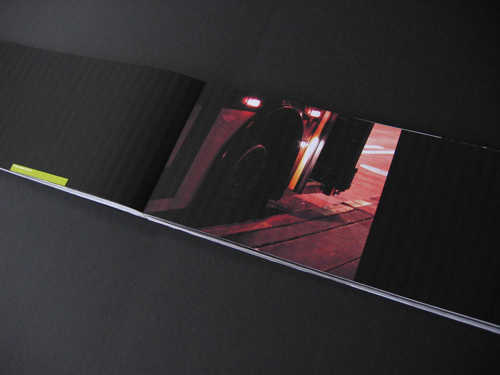
If These Wheels Could Talk spread (bus arriving at night); 34 x 6.5in., 116ppg. / 2004
If These Wheels Could Talk spread (bus arriving at night); 34 x 6.5in., 116ppg. / 2004
Day breaks one more time to shine a light on the last story, which is primarily about getting off the bus, picking up on someone who meant to be picked up by another number. The ride stops before it starts and so the story goes away.
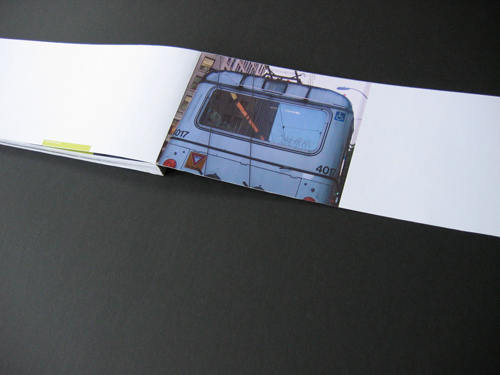
If These Wheels Could Talk spread (story leaving); 34 x 6.5in., 116ppg. / 2004
After all these years, and so many projects before and since, many for some of the most interesting organizations in the world, this book still holds a place very close to my heart. It was the bus that took me from one formative experience to another for much of my life, and it was the bus that drove me back to my life’s design.
I realized halfway into that drive down south that, for all the good that the bus embodied, I wasn’t meant to be its driver. For better or worse, I was always supposed to be a designer, and so I turned the car around and went back home. Shortly thereafter, I filled out some other government forms and reapplied to the University of Washington, where I went on to go through the VCD program. In the rite of passage from school to re-entry into career, it felt right to pay due respect to the wheels that got me there.

